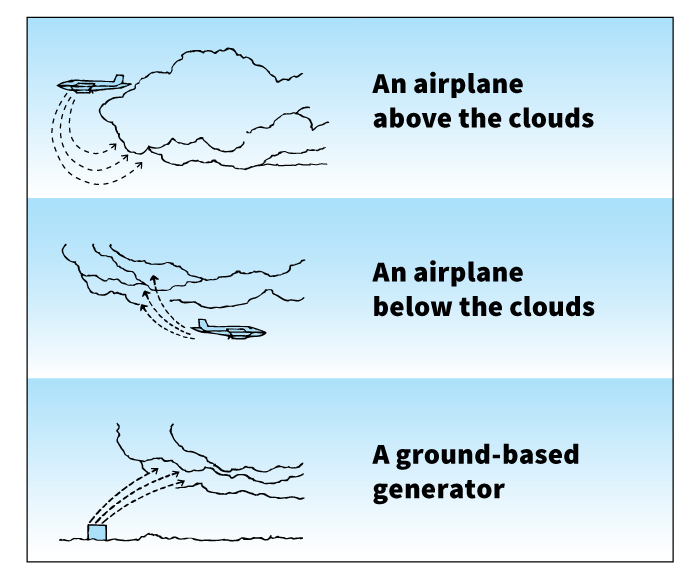Cloud seeding, also called rainmaking, is a process that attempts to cause clouds to produce rain. People chiefly use cloud-seeding methods to increase an area’s supply of water for home and business use, irrigating crops, or generating hydroelectric power. Several United States scientists, working independently, developed cloud-seeding techniques during the 1940’s.
Rain occurs when water droplets or ice crystals in clouds grow large and heavy enough to fall to Earth’s surface. In some cases, adding substances called seeding agents to clouds can increase the chance of rain or snow. Seeding works best in clouds where conditions are close to those that produce rain. The seeding agent used depends on the cloud’s temperature.
Cloud-seeding methods.
For clouds at temperatures above 32 °F (0 °C), cloud seeders use hygroscopic (water-attracting) seeding agents. Microscopic particles of salts, such as potassium chloride, often serve as hygroscopic seeding agents. Specially designed flares mounted on the wings of airplanes release the seeding agent just below the base of a cloud. Upward airflows called updrafts carry the seeding agent into the cloud. Inside the cloud, hygroscopic agents attract water, creating relatively large droplets. These droplets fall quickly, colliding and combining with smaller, slower-falling droplets. Through repeated collisions, the droplets eventually grow into large drops that fall out of the cloud as rain.

At temperatures below 32 °F, rain develops in clouds that contain a mixture of ice crystals and supercooled water droplets. Supercooled water can remain liquid at temperatures as low as –40 °F (–40 °C). These cold clouds produce rain when ice crystals grow large enough to fall toward Earth’s surface as snowflakes. As the flakes enter a region of the atmosphere that is warmer than 32 °F, they melt into raindrops. This process fails to occur when a cold cloud contains mostly supercooled water droplets and few ice crystals.
To make up for the absence of ice crystals, scientists can seed cold clouds with pellets of dry ice. Dry ice is frozen carbon dioxide at temperatures as low as –112 °F (–80 °C). An airplane drops the pellets directly into a cloud’s updraft. Inside the cloud, the dry ice chills the supercooled water droplets, causing them to freeze into ice crystals. As they fall, the crystals melt into raindrops.
Another method uses silver iodide crystals to seed cold clouds. Silver iodide crystals have properties similar to ice and can cause ice crystals to form around them. Flares or devices called generators produce a vapor containing silver iodide crystals. Airplanes usually release the crystals in the cloud’s updraft. Ground-based generators can distribute silver iodide crystals if winds are strong enough to carry them into the clouds.
Arguments about cloud seeding.
Cloud seeding has caused much debate because scientists have not been able to demonstrate that it works well in all cases. In addition, some people argue that cloud seeding merely redistributes a fixed supply of rainfall. They worry that producing rain in one area may cause shortages of rainfall elsewhere. Many states of the United States regulate or even prohibit cloud seeding.
